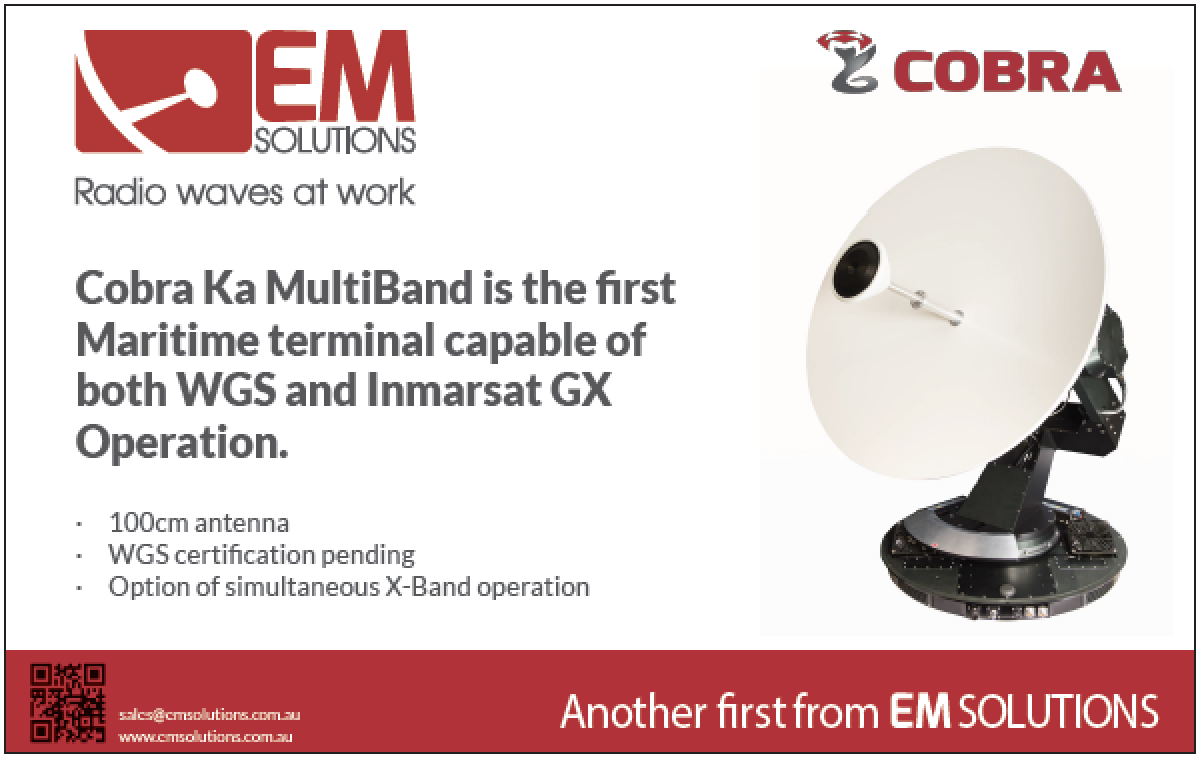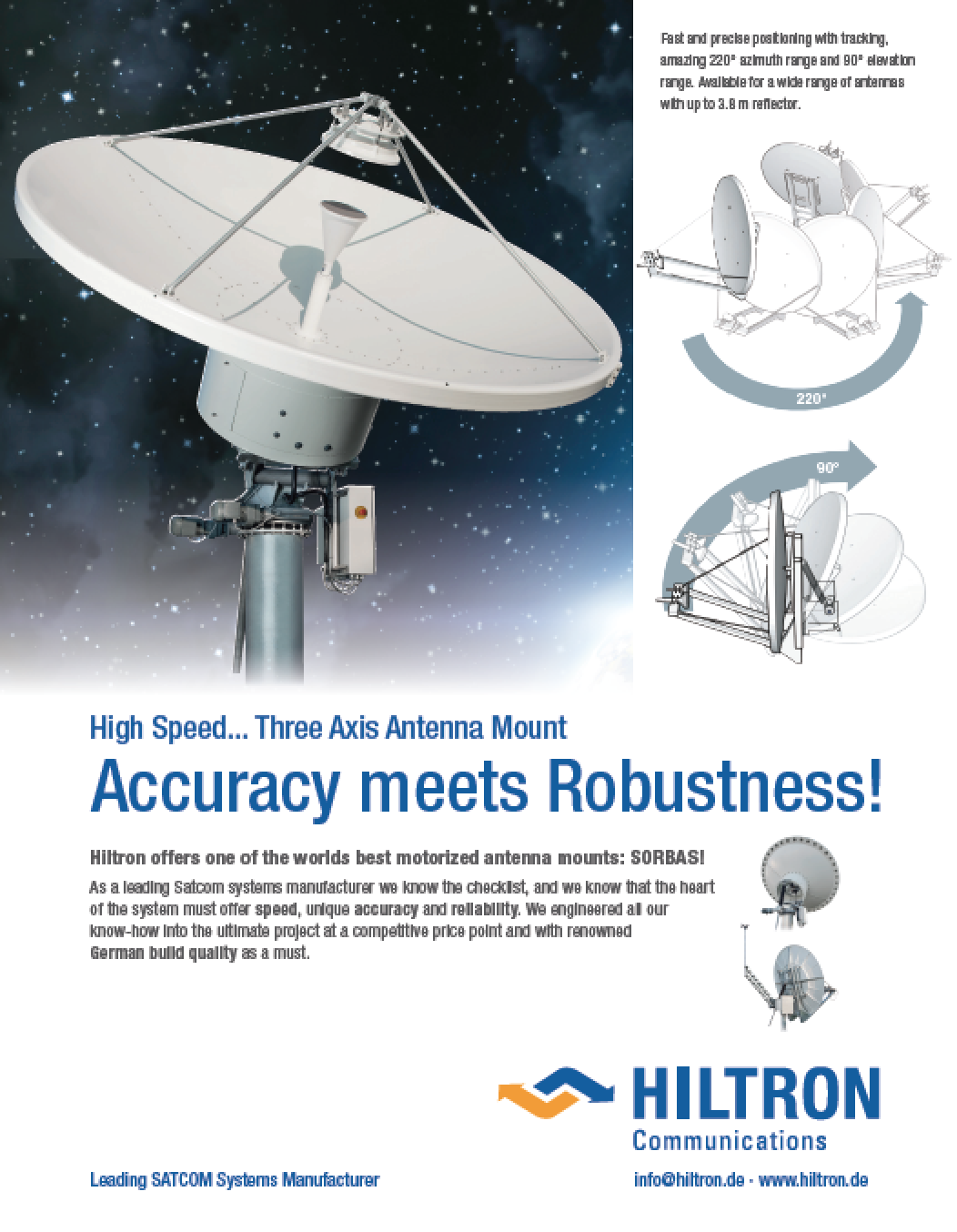Boeing Heading Into South Australia
Boeing opened an office in South Australia and their new Adelaide office will support advanced military systems and leading edge research and development over the long term—the hub will work closely with universities, other tertiary institutions and research organizations.
Boeing’s presence in Australia is already its largest outside of the United States, employing more 3,000 staff nationally, with the majority in Queensland. However, this will be the first time the company has had a presence in South Australia, which is positioning itself as the nation’s “Defence State.” Adelaide is poised to become a global centre of excellence for the defence sector with more than AU$100 billion worth of major industry projects in the pipeline.
South Australia has a long history in the space industry, which started when the Woomera Test Range was established in 1947 about 450km north of Adelaide. The outback range is still used and last year launched an experimental rocket flight as part of a joint research program, HIFiRE (Hypersonic International Flight Research Experimentation Program).
In October 2016, South Australia and the Agenzia Spaziale Italiana (ASI) agreed to jointly pursue space-related industries. In September, Adelaide will host more than 3,000 delegates from around the world at the 68th International Astronautical Congress (IAC).
www.boeing.com
A Super Swarm of Smallsets — The QB50 Project Continues
With the successful delivery of cargo to the International Space Station (ISS) via Orbital ATK’s Cygnus spacecraft late last month, having launched aboard a United Launch Alliance Atlas V rocket from Cape Canaveral, there was a great deal to celebrate… not only was the crucial cargo successfully delivered, but 36 smallsats — a “swam” — part of the QB50 mission — were also aboard the Cygnus for delivery to the ISS for later individual launches to their specified orbital slots.
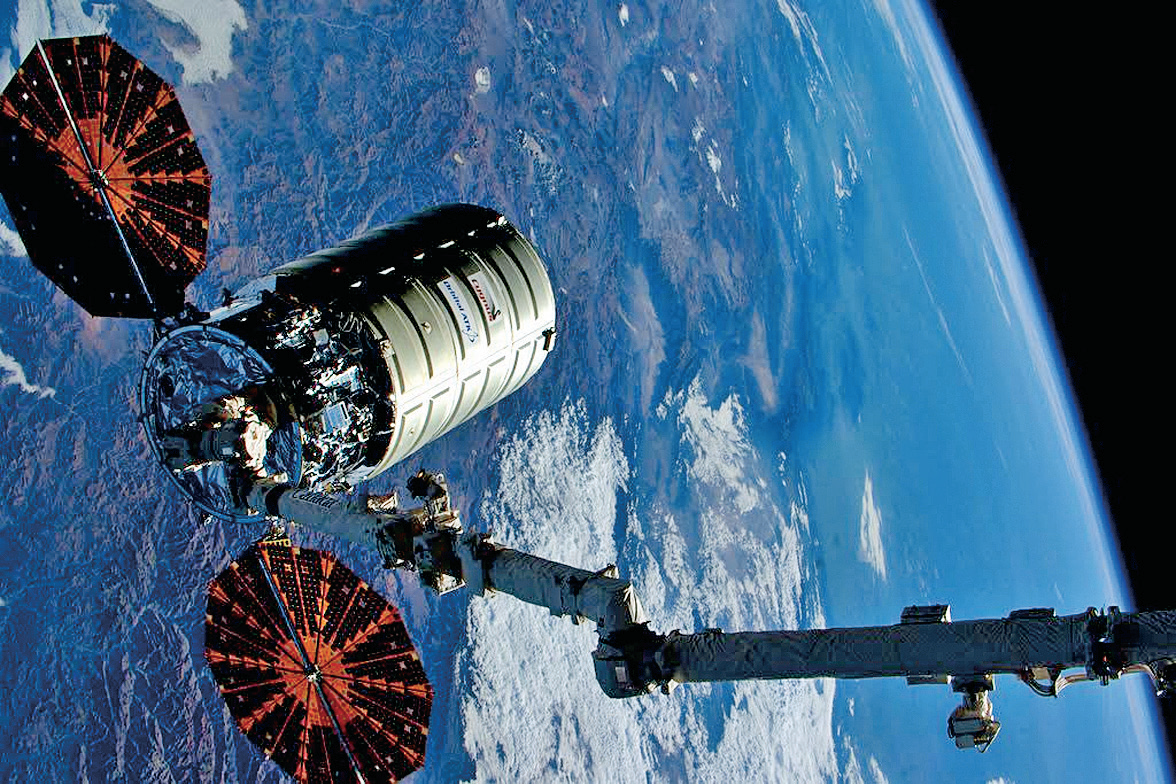
Orbital ATK’s Cygnus OA-7 mission is the third one to arrive at the ISS via a United Launch Alliance (ULA) Atlas V. Photo credit: NASA/Scott Kelly/Twitter
Twenty-eight of these satellites are part of the ongoing QB50 (www.qb50.eu) mission that is funded by the European Union’s Seventh Framework Program for Research and Technological Development and managed by the von Karman Institute for Fluid Dynamics (www.vki.ac.be), with NanoRacks (nanoracks.com) being the launch provider with full NASA (www.nasa.gov/mission_pages/station/research/experiments/2539.html ) support.
The QB50 project, when completed, will present a network of smallsats that have been designed and built by universities from around the world.
These smallsats will drive science projects that will investigate the lower thermosphere between 200 to 380 kilometers in altitude, which is the layer of the Earth’s atmosphere that resides between the lower mesosphere (the least understood portion of the atmosphere) and the upper exosphere, within which particles remain gravitationally bound to Earth — this is considered to be the transitional area between the atmosphere of Earth and space itself.
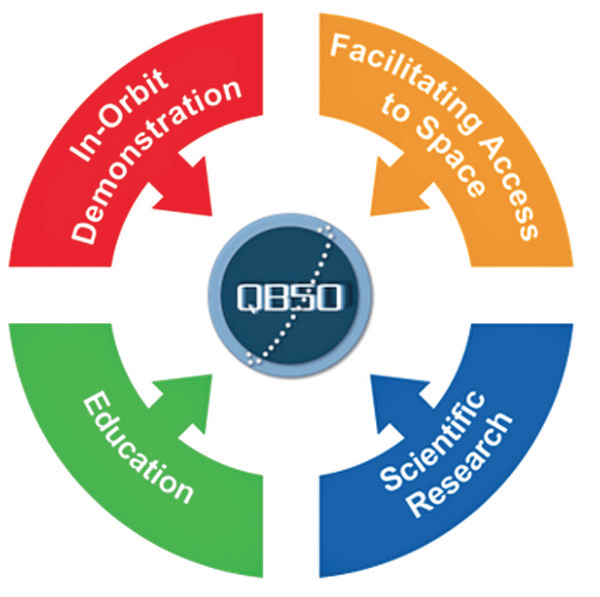
The thermosphere, within which the ISS orbits, completely absorbs solar X-ray and extreme ultraviolet radiation at wavelengths <170 nm and solar winds are transferred to the magnetosphere through this portion of the Earth’s atmosphere, although the mechanics of how such is accomplished is not currently well understood.
The thermosphere defends Earth against cosmic rays, solar flare radiation and unpredictable space weather, all of which can make life miserable for GPS units, mess up power grids as well as instigate mass blackouts.
There are three science sensor sets that will be employed by this network, with all of the cubesats including Thermistors/thermocouples/TTD (TH) as part of their payloads.
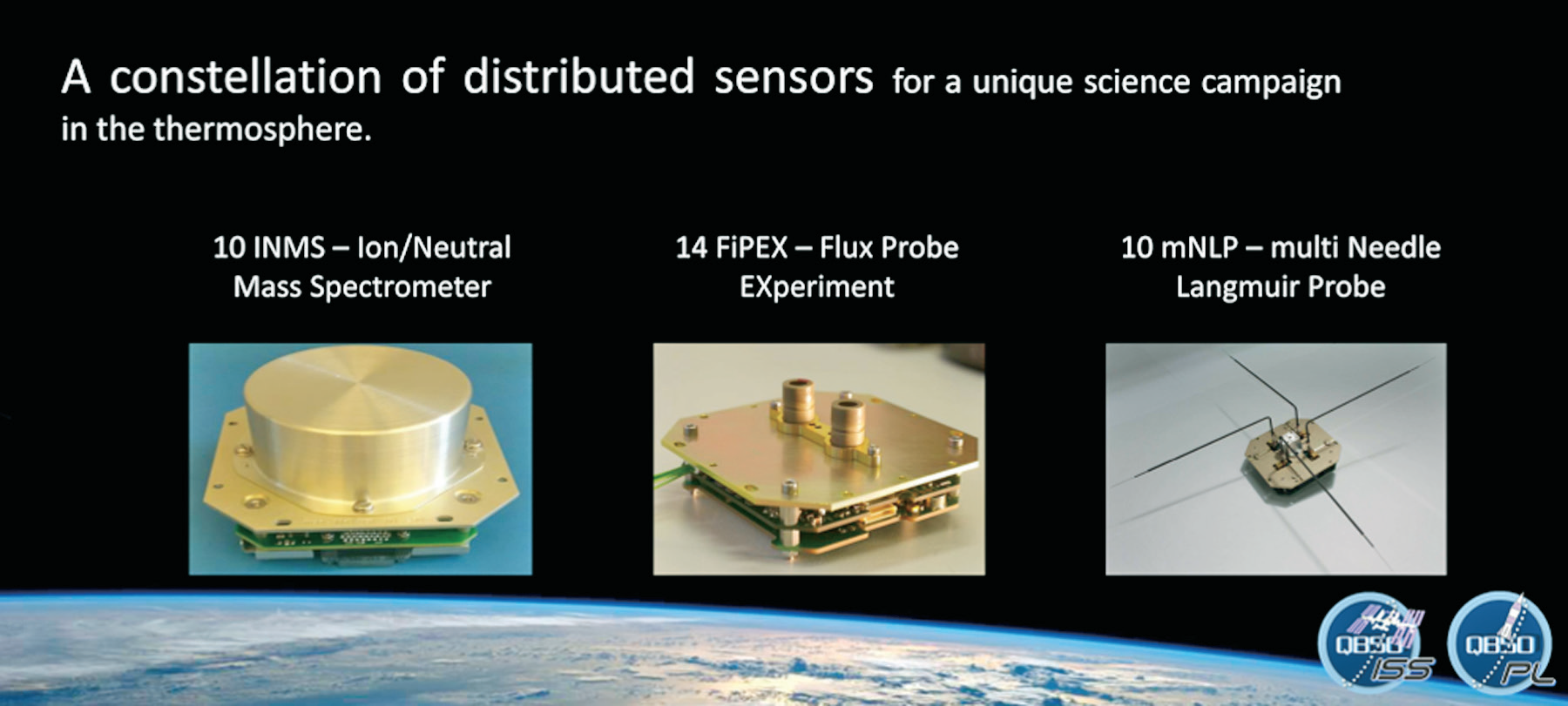
Set 1 includes the Ion-Neutral Mass Spectrometer (INMS) to study low mass ionized and natural particles in the lower thermosphere.
Set 2 includes the Flux-ø-Probe Experiment (FIPEX), to precisely determine the content of molecular and atomic oxygen in the thermosphere.
Set 3 brings the multi-Needle Langmuir Probe (m-NLP), to characterize the masses of electrons in the ionosphere.
Another objective of this particular launch was to support smallsats for technology demonstrations — the spacecraft involved in this endeavor will be carrying their own, specific payloads for space qualification to ensure payload reliability and veracity within the hostile environs of space.
The life expectancy of the satellites is between six and 12 months and, upon completion of their tasks, they will re-enter the Earth’s atmosphere for cremation.
All of the hardware was turned over to NanoRacks LLC in Houston, where 29 of the smallsats were integrated into the firm’s NanoRacks 6U deployers by the joint team at Innovative Solutions in Space B.V. in
the Netherlands (www.isispace.nl.)
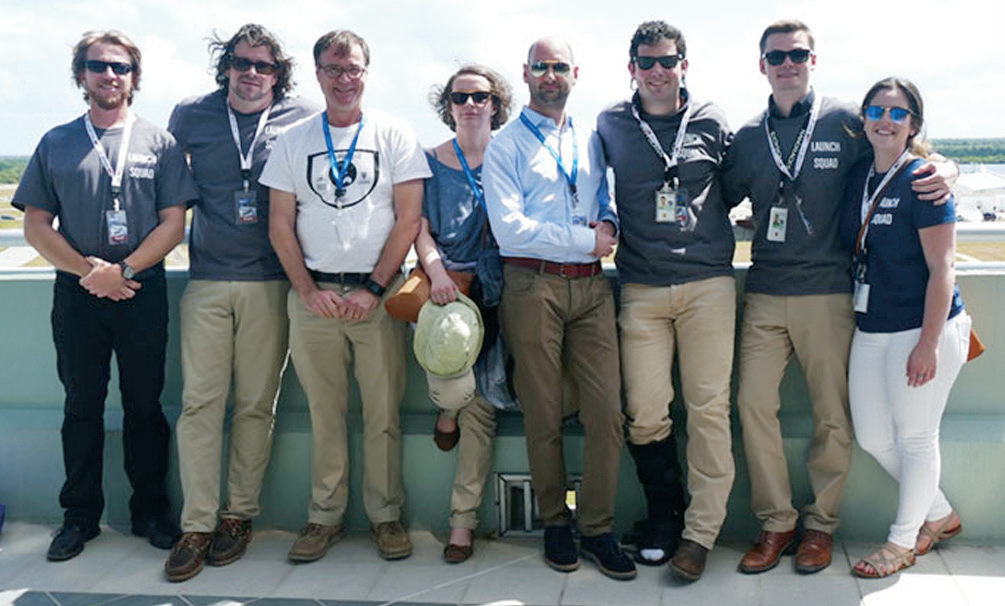
The Inspire 2 team post-launch photo, courtesy of the University of Sydney.
The filled deployers were then shipped to Lockheed Martin, the firm that is responsible for the Cargo Mission Contract. Lockheed Martin then loaded the deployers into the Orbital ATK Cygnus CRS-OA spacecraft for their delivery to the ISS aboard the aforementioned Atlas V rocket.
...the QB50 smallsat inclusions…
Australia
From the University of Sydney (sydney.edu.au/), Inspire-2 — a 2U cubesat — required approximately 1-1/2 years of effort to design and build from Commercial-Off-The-Shelf (COTS) components and packs five research instruments.
Professor Iver Cairns, the project lead, stated that these smallsat payloads will provide unique scientific data on Earth’s upper atmosphere (specifically the ionosphere and thermosphere) and space weather.
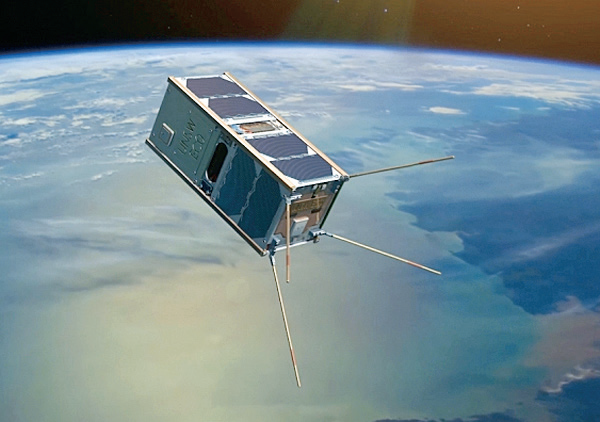
Artistic rendition of UNSW-EC0 cubesat.
They will also demonstrate new Australian technologies in space, specifically a ‘photonic lantern’ to study the spectrum of light from the Earth and other objects, plus a GPS receiver to study GPS signals reflected off the sea and refracted through the atmosphere.
The University of New South Wales (www.unsw.edu.au/) UNSW-EC0 effort is equipped with an INMS that will strip the electrons from atoms that are sticking to the satellite’s onboard detector to determine the composition of those elements and other payloads, and to analyze the effects of space radiation on various components and smallsat formation flying.
The SUSat, a joint project by the University of Adelaide (www.adelaide.edu.au/) and the University of South Australia, also includes similar scientific gathering instruments as the aforementioned Australian smallsats.
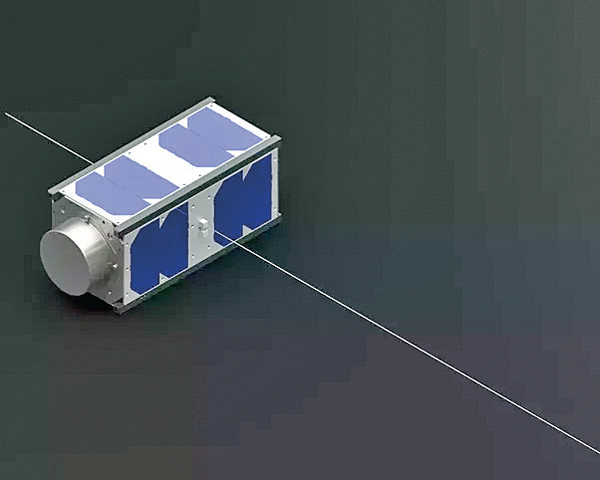
Artistic rendition of LilacSat-1.
Belgium / China
Students at the Harbin Institute of Technology (en.hit.edu.cn/) constructed the LilacSat-1 and obtained hands-on experience building this spacecraft that will engage in amateur radio communications and is also a technology demonstration. This 2U cubesat’s payloads include an INMS, A V/U digipeater and a thermal infrared camera, which will enable licensed radio amateurs to send a command to the satellite to capture an image and then download that data to them.
Canada
Collin Cupido and Charles Nokes are part of the team of students from the University of Alberta (www.ualberta.ca/) that received funding from the Canadian Space Agency to build the 3U Ex-Alta 1 CubeSat and participate in the international QB50 mission.
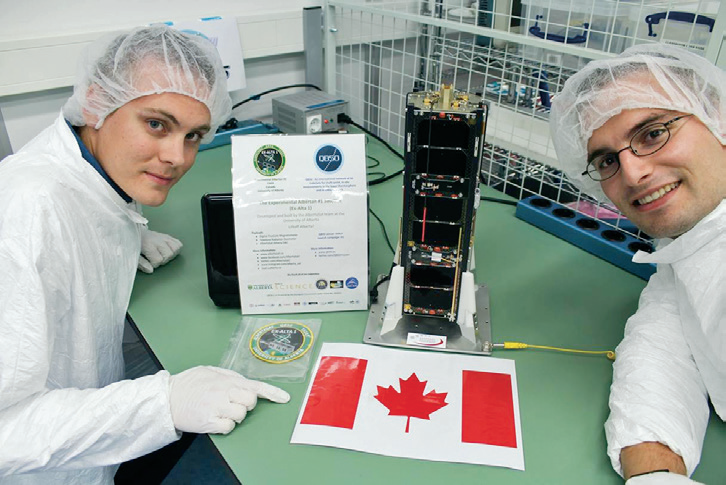
Photo courtesy of University of Alberta.
With funding provided by the Canadian Space Agency, these and other students from the University of Alberta built a cubesat that was propelled into space as one of the smallsat payloads aboard the Orbital ATK Cygnus launch last month. The cubesat was dropped off at the International Space Station as part of the international QB50 mission. This 3U cubesat is named Ex-Alta 1 and will collect information on space weather with the help of a miniaturized version of a science instrument called a magnetometer, an essential tool for studying solar storms.
Ian Mann, the Professor of Physics at the university, explains more about the smallsat in a video produced by the Science department at the University of Alberta at www.youtube.com/watch?v=WUC6lHh_Gmg.
China, People’s Republic of,
The NJUST 1 2U cubesat is packing a FIPEX sensor as the primary payload and this smallsat was designed and built at Nanjin University of Science and Technology (english.njust.edu.cn/). Data will be exchanged via supplied network resources, ensuring that even when the satellite is not in view of a ground station, information will still be received by interested parties.
The Northwestern Polytechnical University (http://en.nwpu.edu.cn/), under the leadership of Dr. Yu Xiaozhou, developed a 2U cubesat named Aoxiang-1, which totes an INMS sensor and is also set to launch from the ISS.
Finland
Based on the research realized from the development and launch of the nation’s first satellite, Aalto-1, the follow-up Aalto-2 was included in this mission.
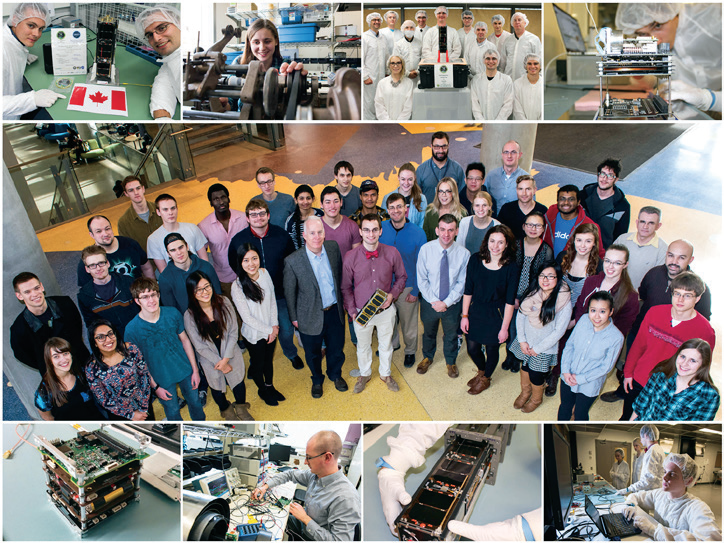
Mosaic showing the members of the AlbertaSat team and the various steps involved in building the Ex-Alta 1 CubeSat. Photo credits: Collin Cupido, Charles Nokes, University of Alberta.
Built by the Aalto University School of Electrical Engineering (http://elec.aalto.fi), the work on this smallsat started in 2012 as a doctoral project and further develops the technologies started during Aalto-1, according to Assistant Professor Jaan Praks.
Aboard this cubesat is an mNLP payload that was developed at the University of Oslo to measure the characteristics of plasma and the overall demonstration by this smallsat is to test the spatial viability of the design and components.
France
A 2U cubesat was developed by students at École Polytechnique (www.polytechnique.edu/) to engage in various comms experiments as well as an educational tool.
This smallsat — X-CubeSat — carries a FIPEX sensor as well as a transponder for amateur FM. An additional French cubesat is from Mines ParisTech (www.mines-paristech.fr) and is called the SpaceCube. The payload is identical to the previously mentioned French university satellite.
Germany
Technische Universität Dresden’s (https://tu-dresden.de/) 2U SOMP2 (Student’s Orbital Measurement Project) cubesat accommodates three payloads, all developed at this university. The payloads include FIPEX, C-REX that examines the electrical properties of carbon nanotubes under the influence of space conditions, and the TEG payload that will probe the feasibility of harvesting energy.
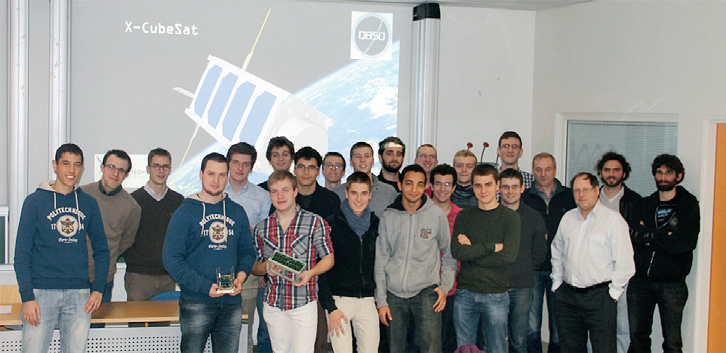
(The X-Cubesat team)
Greece
DUTHSat from the Department of Electrical and Computer Engineering of the Democritus University of Thrace (www.duth.gr/) obtained funding from the European Social Fund and National Resources, as well as a contribution toward the launch costs from Raycap S.A., a Greek firm engaged in telecomm and other applications around the globe.
The satellite was built by young engineers at the university and has been an asset to those following undergrad and graduate diploma theses on space electrodynamics and satellite subsystems.
Also from a Greek university — University of Patras (www.upatras.gr) — and the Libre Space Foundation (https://libre.space/), their UPSat cubesat joined this up and coming swam and was delivered to the ISS for launch.
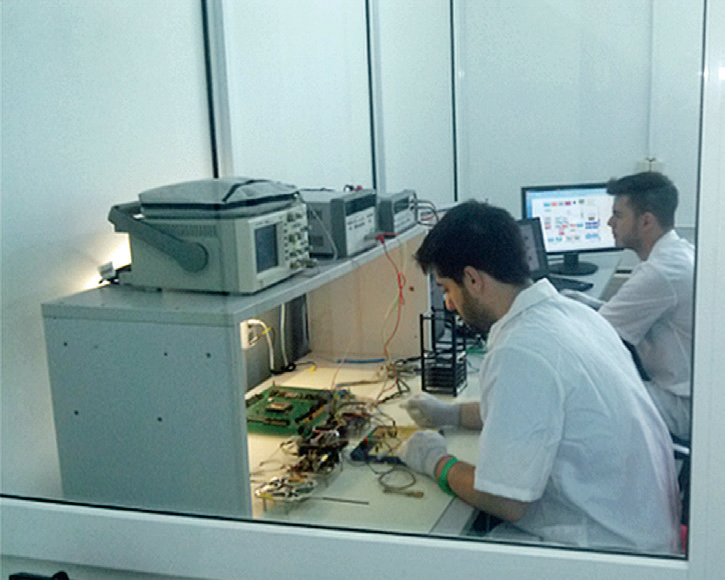
Members of the DUHSat team at work.
This spacecraft is described as the first open source hardware and software satellite. This is a 2U cubesat and also minimized the use of COTS components to minimize the costs of development and build. There was a mass savings realized and enhanced mechanical properties through the use of an aluminum frame.
Israel
This second produced satellite from the Herzliya Science Center (www.idc.ac.il/) was developed by the students and is known as Duchifat, or, Hoopoe 2. The cubesat, similar to the others in the QB 50 project, will take lower thermosphere measurements, which will then be communicated to the Herzliya Science Center for interpretation by the students.
Also onboard are thermistors and a magnetometer instruments. Also of note is the nation’s upcoming and rather complex project that includes the planning, programming, construction and launch of 70 cubesats by 70 different high schools in Israel. This launch event in 2018 will be in celebration of the nation’s 70th birthday.
South Africa
The South African nanosatellite, ZA-AeroSat, weighs in at 2 kg and is the only satellite from Africa to form part of this international project, and will gather measurements from the lower thermosphere via the smallsat’s FIPEX sensor.
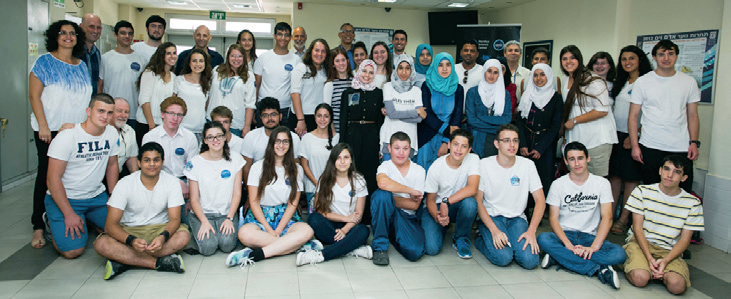
Israel’s Hoopoe2 team.
The satellite was completed by the Electronic Systems Laboratory in the university’s Department of Electrical and Electronic Engineering and CubeSpace at Stellenbosch University (www.sun.ac.za/)
CubeSpace is already widely recognized internationally for innovative smallsat orientation control systems and they supplied 15 control units (attitude determination and control systems [ADCSs]) to other satellites in the QB50 project, according to Professor Herman Steyn, who heads up this project and is the founder of CubeSpace. He added that the ESL/CubeSpace unit developed ZA-AeroSat’s onboard computer (CubeComputer) and the attitude control system (CubeSense and CubeControl) for use in space.
A second satellite from South Africa’s commercial joint venture SCS Space (www.scs-space.com/) and Pinkmatter Solutions, named nSIGHT-1, is also a member of this smallsat troupe, packing a FIPEX sensor as well as the company’s compact RGB Gecko imager camera which has a ground sampling distance of around 30 meters.
The satellite was designed, integrated and tested by the Space Advisory Company and then assembled at NewSpace Systems in their clean room, both part of the aforementioned SCS Aerospace Group.
Also to be tested during the smallsat’s on orbit maneuvering is a Nelson Mandela Metropolitan University patented Radiation Mitigation VHDL Coding Technique.
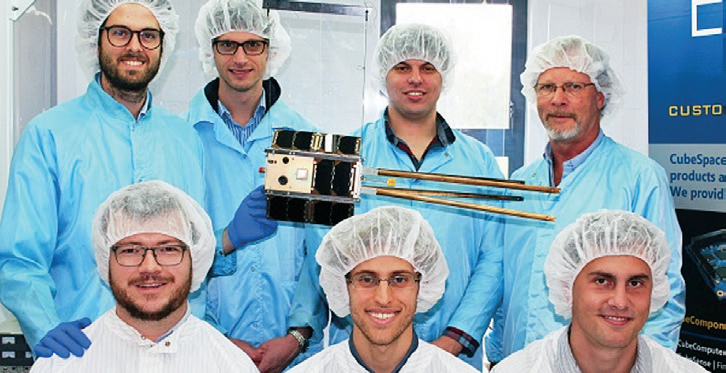
The SCS Space team.
South Korea
Called the Little Intelligent Nanosatellite of KAIST, or, LINK, this 2U cubesat was designed at KAIST University (www.kaist.edu/) and carries the INMS sensor.
Additionally, there are two Langmuir probes that were developed in-house by the agency and this diagnostic tool will determine the electron temperature, density and potential of a plasma.
From Seoul National University’s (www.useoul.edu/) Satellite Team come the 2U SNUSAT-1 and SNUSAT-1b cubesats.
The undergrads within the Department of Mechanical Space Engineering and Department of Electric Engineering founded the SNUSAT organization in 2010 and the satellites they subsequently built were for educational purposes, as well as to present valid entries into international smallsat competitions.
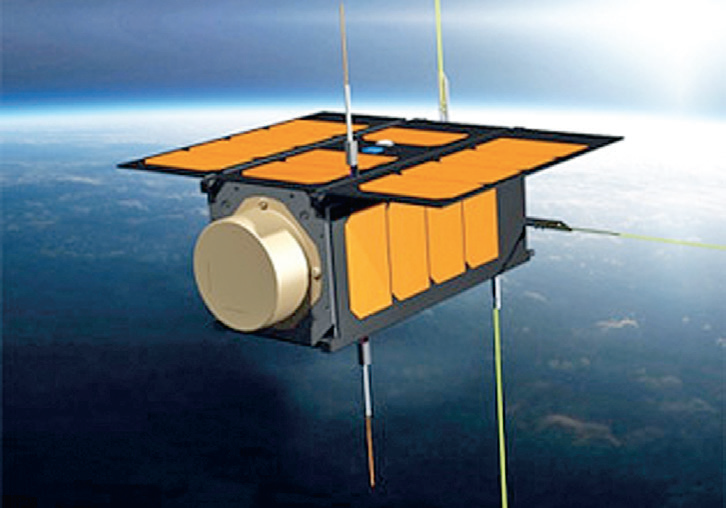
Artistic rendition of the LINK cubesat.
As is similar to the other cubesats, SNUSAT-1 will measure lower thermosphere constituents via the primary FIPEX instrument as well as validate fault-detection, isolation and recovery algorithms that were developed by Seoul National Unit and imaging space environment. The advisors for SNUSAT are Professor In Seuk Jeung and Ph.D. candidate Jihyn Park.
Spain
The 2U cubesat known as QBITO is the first smallsat to be developed by the Polytechnics University of Madrid (www.upm.es/). There are three payloads. The first was developed in conjunction with the University of Liege and will assess the performance of the n-Octadecane (a reference substance used for gas chromatograph) as a Phase Change Material, or PCM.
Spanish firm New Infrared Technologies developed a Medium Wave Infrared Detector for testing, and the third instrument is an attitude determination and control system algorithm based on fuzzy control theory.
Sweden
Lulea University of Technology (www.ltu.se) developed the qbee 2U cubesat along with Open Cosmos (open-cosmos.com/).
The satellite was developed using a payload development kit known as qbkit that simulates the interfaces and behavior of a satellite bus in orbit conditions. In combo with qbapp, this package allows for payload development at a fraction of the current cost of such work, according to developer Open Cosmos.
The edu board, main power converter, USB cable and limited access to qbapp are included with this package… a link is also included for the 3D files for the structure itself, which can be 3D printed. On board is a FIPEX sensor.
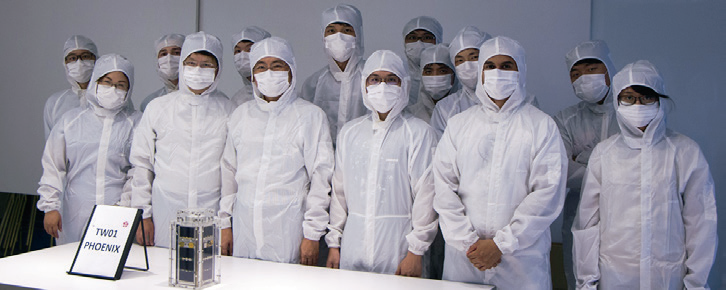
Photo of the PHOENIX team with their cubesat.
Republic of China / Taiwan Province
Traveling on the 2U cubesat from the National Chenk Kung University (NCKU — web.ncku.edu.tw/) SPACELAB is Phoenix with three mission payloads that include solar EUV sensors, thermistor as well as an INMS sensor. The SPACELAB was established in 2003 and has been involved in a number of smallsat projects. The first smallsat from this organization was the PACE nano that launched in 2014.
Turkey
Istanbul Technical University (www.itu.edu.tr) and the Turkish Air Force Academy built the BeEagleSat, a 2U cubesat with an attitude determination and control system-ADCS as well as an m-NLP. A secondary payload is comprised of an X-ray detector, a communication and satellite management system (OBCOMS), both provided by project partners.
The second smallsat from Turkey is the HAVELSAT, also a 2U unit that packs one functional and one scientific unit, the latter being a Software Defined Radio (SDR) for comms. Additionally, this smallsat will also be performing small scale, onboard
image processing.
This cubesat was built by HAVELSAN (www.havelsan.com.tr/), a software and systems government owned corporation with interests in the defence and IT sectors, and Istanbul Technical University.
Ukraine
The National Technical University of Ukraine (http://inter.kpi.ua), also known as the Kyiv Polytechnic Institute, brought their smallsat named PolyITAN-2-SAU to the QB50 project. This inclusion was made possible due to sponsorships from Shenyang Aerospace University in the People’s Republic of China, the Kalinin Fund, “Diona” Limited and “Boeing-Ukraine Limited.” Students built the smallsat under the guidance of senior researcher Borys Rassamakin.
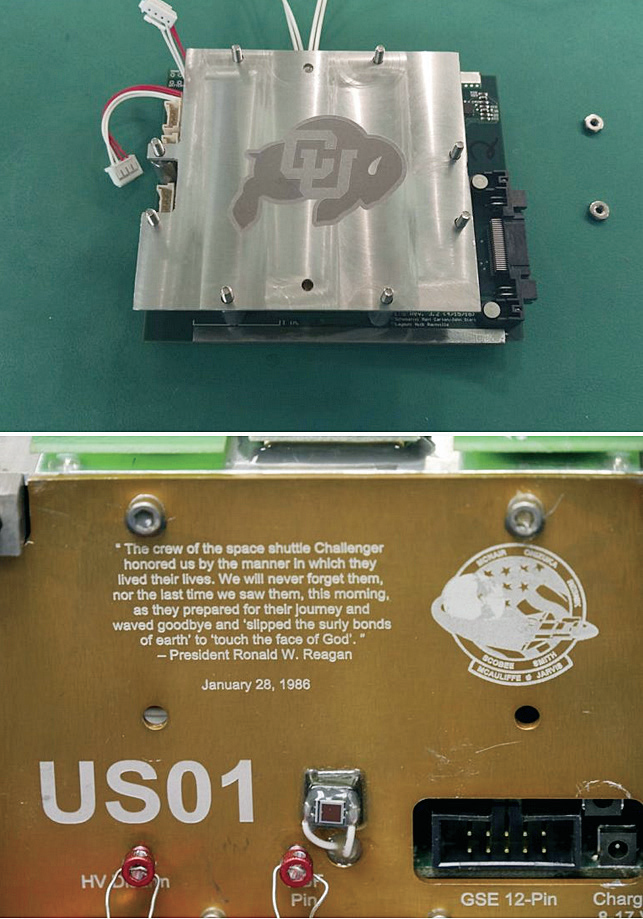
United States
Two satellites from US universities are the result of the work of the QBUS consortium that is comprised of subject-matter experts from Stanford University, Johns Hopkins Applied Physics Laboratory, University of Michigan, University of Colorado and the Universidad del Turbo Puerto Rico. Each member organization provides the expertise for their individual smallsat, such as on-board CPU data handle and storage, uplinks and downlinks, attitude determination and satellite control as well as project management and system engineering.
The University of Colorado’s (www.cu.edu) entry into this phase of the QB50 project is the 2U Challenger cubesat, also known as QBUS 1. This smallsat was designed and built by a multidisciplinary team of students at the University of Colorado Boulder and carries the ion-neutral mass spectrometer as a science instrument and has history from the Colorado Student Space Weather Experiment (CSSWE) and Miniature X-Ray Spectrometer (MinXSS) cubesats.

Many of the cubesat subsystems were designed, built and tested by students in the Space Technology Integration (STIg) lab. There are a number of personal touches aboard this spacecraft, as well, such as an engraved CU Boulder buffalo on the interior as well as a memorial to the satellite’s namesake, the US Space Shuttle Challenger, which is especially poignant as the mission specialist on the Challenger Shuttle flight was CU Boulder aerospace graduate Ellison Onizuka.
QBUS 2, otherwise known as Atlantis, is a 2U swarm inclusion from the University of Michigan (www.umich.edu/). This 2U cubesat carries the FIPEX probe.
QBUS 4, also named Columbia, is from the Universidad del Turbo (ut.suagm.edu/) in Puerto Rico and their 2U cubesat includes the FIPEX sensor.
www.qb50.com.




